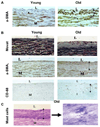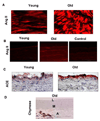Arterial aging and subclinical arterial disease are fundamentally intertwined at macroscopic and molecular levels
- PMID: 19427493
- PMCID: PMC2943242
- DOI: 10.1016/j.mcna.2009.02.008
Arterial aging and subclinical arterial disease are fundamentally intertwined at macroscopic and molecular levels
Abstract
The structure and function of arteries change throughout a lifetime. Age is the dominant risk factor for hypertension, coronary heart disease, congestive heart failure, and stroke. The cellular/molecular proinflammatory alterations that underlie arterial aging are novel putative candidates to be targeted by interventions aimed at attenuating arterial aging as a major risk factor for cardiovascular diseases. This review provides a landscape of central arterial aging and age-disease interactions, integrating perspectives that range from humans to molecules, with the goal that future therapies for cardiovascular diseases, such as hypertension, also will target the prevention or amelioration of unsuccessful arterial aging.
Figures








References
-
- Najjar SS, Scuteri A, Lakatta EG. Arterial aging: is it an immutable cardiovascular risk factor? Hypertension. 2005;46(3):454–462. - PubMed
-
- Lakatta EG, Levy D. Arterial and cardiac aging: major shareholders in cardiovascular disease enterprises: part I: aging arteries: a “set-up” for vascular disease. Circulation. 2003;107(1):139–146. - PubMed
-
- Najjar SS, Lakatta EG. Vascular aging: from molecular to clinical cardiology. In: Patterson WC, Runge M, editors. Principles of molecular cardiology. Totowa (NJ): Humana Press; 2005. pp. 517–547.
-
- Wang M, Lakatta EG. Central arterial aging: humans to molecules. In: Safar M, editor. Handbook of hypertension: arterial stiffness in hypertension. Amsterdam: Elsevier; 2006. pp. 137–160.
-
- Lakatta EG. Central arterial aging and the epidemic of systolic hypertension and atherosclerosis. J Am Soc Hypertens. 2007;1(5):302–340. - PubMed
Publication types
MeSH terms
Substances
Grants and funding
LinkOut - more resources
Full Text Sources
Medical

